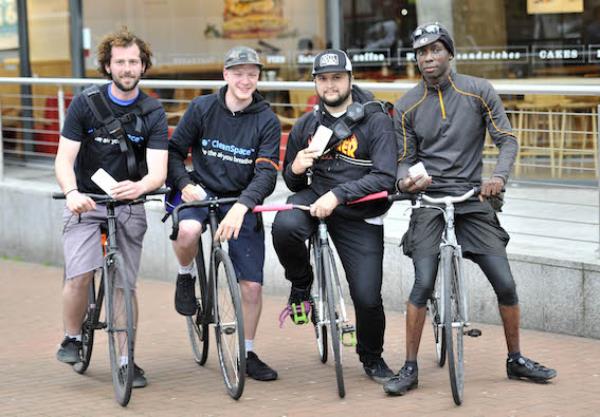20 July 2016
Gophr’s cycle couriers will be equipped with LoRa powered tracking devices that monitor air pollution levels in real-time.
Drayson Technologies has unveiled plans to build the world’s most advanced air pollution map.
UK cycle courier company Gophr will equip 50 of its riders across London with CleanSpace Tags.
These portable air pollution sensors are powered by Drayson’s innovative Freevolt technology. The couriers will map pollution levels on their journeys across the capital, collecting data that will help to build a real-time map of the city’s air pollution.
In what’s said to be the first example of a public LoRa network in London, the couriers will be equipped with devices that use the long range IoT technology. These will track the couriers’ locations via satellite connectivity provided by Inmarsat, negating the need to use mobile location based services which drain battery life. It also means fewer access points are needed to cover the whole city.
According to Drayson, the system will enable highly accurate, real-time location and height information to be collected on the move. The carbon monoxide data collected from the tags will feed into the interactive Air Map that will show the actual pollution levels at each courier’s location.
With the cyclists predicted to travel more than 17,000 miles each month, the company claims says the amount of indoor and outdoor air pollution data collected will be on a scale that has never been achieved previously.
Gophr and Inmarsat are the first partners announced in Drayson’s plan to create the world’s most advanced air pollution map of a city.
Further organisations, groups and individuals will be equipped with CleanSpace Tags in the coming months in order to collect data, gather insights, and help address the issue of air pollution in the capital.
Paul Drayson (centre) believes Freevolt solves the problem of harvesting usable energy from a small RF signal. Also pictured: Gophr founder Seb Robert (left) and Inmarsat’s Greg Ewert.
Harnessing wasted RF energy
The CleanSpace Tag is a personal air pollution smart sensor that enables people to measure and monitor the pollution levels in the air they breathe, wherever they are, at any time.
It is the first product to be powered by Freevolt, a revolutionary technology launched by Drayson Technologies that harvests and recycles wasted wireless signals to power low-energy devices so their batteries never need changing. The tag works alongside the CleanSpace mobile app, allowing users to view their exposure to air pollution through the interactive Air Map.
Developed by an international team from Drayson Technologies and London’s Imperial College, Freevolt harnesses the unused wireless energy generated by transmission signals on mobile, Wi-Fi and broadcast networks.
Drayson Technologies CEO and chairman Paul Drayson – the Labour peer who also served as Science and Innovation minister in Gordon Brown’s government – believes his company's technology solves the problem of harvesting usable energy from a small RF signal.










